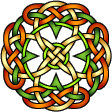 Mac Gregor
Mac Gregor
 |
The Clan Gregor held lands in
Glenstrae, Glenlochy and Glenorchy. Sir Iain
Moncreiffe believed that they were descended from
the ancient Celtic royal family through the
hereditary Abbots of Glendochart, a descent which
may be proclaimed in the motto, "Royal is my
race". There is no evidence to support the
tradition that Gregor was the son of Kenneth
Macalpin. He may have been Griogair, son of
Dungal, who is said to have been a co-ruler of
Alba, the kingdom north of Central Scotland,
between AD 879 and 889. Most modern historians
agree that the first certain chief was Gregor
"of the golden bridles". Gregor's son,
Iain Camm, One-eye, succeeded as the second chief
sometime prior to 1390.
Robert the Bruce granted the
barony of Loch Awe, which included much of the
Mac Gregor lands, to the chief of the Campbells.
In common with many royal gifts of the time, it
was left to the recipient to work out how he
would take possession of it. The Campbells had
already built the stout castle of Kilchurn, which
controlled the gateway to the western Highlands.
They harried the Mac Gregors, who were forced to
retire deeper into their lands until they were
largely restricted to Glenstrae.
Iain of Glenstrae, the second
of his house to be called "the Black",
died in 1519 with no direct heirs. The Campbells
supported the succession of Eian, who was married
to the daughter of Sir Colin Campbell of
Glenorchy. Eian's son, Alistair, fought the
English at the Battle of Pinkie in 1547 but died
shortly thereafter. In 1660 Colin Campbell of
Glenorchy, who had bought the superiority from
his kinsman, Argyll, refused to recognize the
claim of Gregor Roy Mac Gregor to the estates.
For ten years Gregor waged war against the
Campbells. He had little choice but to become an
outlaw, raiding cattle and sheltering in the high
glens. In 1570 the Campbells captured and killed
him. His son, Alistair, claimed the chiefship,
but was unable to stem the tide of persecution,
which was to be the fate of the "Children of
the Mist".
John Drummond, the king's
forester, was murdered after hanging some Mac
Gregors for poaching. The chief took
responsibility for the act, and was condemned by
the Privy Council. In April 1603 James VI issued
an edict proclaiming the name of Mac Gregor
"altogidder abolisheed", meaning that
those who bore the name must renounce it or
suffer death. Mac Gregor, along with eleven of
his chieftains, was hanged at Edinburgh's Mercat
Cross in January 1604. Clan Gregor was scattered,
many taking other names, such as Murray or Grant.
They were hunted like animals, flushed out of the
heather by bloodhounds. Despite their savage
treatment, the Mac Gregors actually fought for
the king during the civil war. When the Earl of
Glencairn attempted a rising against the
Commonwealth in 1651, he was joined by two
hundred of the clan. In recognition of this,
Charles II repealed the proscription of the name,
but this was promptly re imposed when William of
Orange deposed Charles' brother, James VII. It
was at this time that the legendary Rob Roy Mac
Gregor came into prominence. Born in 1671, a
younger son of Mac Gregor of Glengyle, he was
forced to assume his mother's name of Campbell.
His adventures have been immortalized and
romanticized by Sir Walter Scott's novel, Rob
Roy, but there is little doubt that he was a
thorn in the government's flesh until his death
in 1734. When the Stuart flag was raised in 1715,
he attached himself to the Jacobite cause,
although acted largely independently. After the
indecisive Battle of Sheriffmuir, he set out
plundering at will. In one raid he put Dumbarton
into panic, causing the castle to open fire with
its cannon. He is buried in the churchyard at Balquhidder.
The persecution of Clan Gregor
ended in 1774, when the laws against them were
repealed. In order to restore their clan pride,
it was necessary to re-establish the chiefs. A
petition subscribed by eight hundred and
twenty-six Mac Gregors declared General John
Murray of Lanrick to be the proper and true
chief. He was, in fact, a Mac Gregor, being a
descendent of Duncan Mac Gregor of Ardchoille who
died in 1552. The general had served extensively
in India before being created a baronet in July
1795. His son, Sir Evan, was also a general and
later Governor of Dominica. He married a daughter
of the fourth Duke of Atholl, for whom he built
the House of Edinchip, until recently the home of
the present chief. Sir Evan played a prominent
part in the 1822 visit of George IV to Scotland,
where he and his clansmen guarded the honours of
Scotland. He proposed the toast to the
"chief of chiefs"at the royal banquet
in Edinburgh.
The father of the present
chief, Sir Malcolm Mac Gregor, served in the navy
during the First World War, being decorated not
only by his own country, but also by France.



